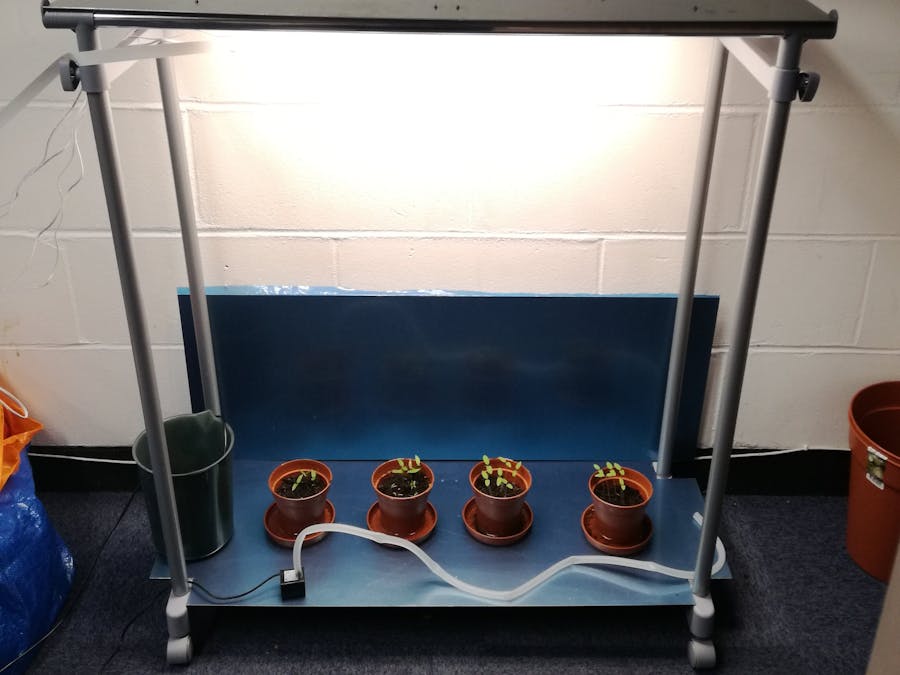Our idea!
You go on holiday and nobody can take care of your plants? Do you want to have good and tasty tomatoes all year? Do you live in a grey country with little sun light, but want to be surrounded by exotic plants? Don't worry, we have the solution for you!
We are building an indoor self-maintaining irrigation system, automatized to water up to 3 different kinds of plants, providing the right amount of light during the cloudy days. Each plant has a humidity sensor that triggers the irrigation system to feed with the right amount of water for each pot. The only thing that you have to do is to fill the water tank with fresh water. But don't worry, a proximity sensor sends you an email when it reaches a filling level below 20%. 4 warm LEDs provide the right amount of illumination. The length of the day and night cycle can be chosen according to your plants needs. There is a temperature sensor and a webcam that stores pictures of the plants every 20 minutes, so you can check the growth in real time.
What else? Everything is mounted on a cloth rail! Why? Because you can adapt the height accordingly to the size of your plant, because it has wheels and as such can be moved easily and, finally, can accommodate different sizes of pots and plants.
Implementation
1) After designing the system, we bought a cloth rail and made 3 customized aluminium sheets (2mm thick) to provide a solid base and ceiling in order to place our pots and the source of illumination. The illumination is provided by 4 warm LED panels, screwed to the ceiling sheet with 4 2M screws. The Webcam is placed with other 4 2M screws in the center of the ceiling sheet, to give a good view on all the plants.
Here some photos of LEDs and webcam.
2) After that, we bought soil, pots, and seeds (tomatoes, peppers and chili peppers) to start the plant cultivation. After 3 weeks, they started to show leaves!
3) We started to play with light conditions. In the end, we decided to have a day cycle of 17 hours that smoothly changes into darkness, mimic a sunset. These options can be easily changed accordingly to the necessities of the plant to grow.
4) Irrigation is provided by a water pump and plastic tubes that connect the water tank (a laboratory beaker nicely painted in green) to the pots. 3 valves divided the water flow in the right pot to water. To the tank is attached a proximity sensor at the height that corresponds to the 20% of the total filling volume. When the water is below the sensor level, the system should send you a warning message, so you know that you have to refill the tank.
5) The irrigation is triggered by the value of the humidity registered by humidity sensors placed in each pot. To find out the right threshold value to start the watering, we have tested different kind of soils containing a different amount of water. For our plants, the right humidity value below which we need the watering, is 80%. We water the plants from the bottom because it is a less invasive way. Of course, between the watering and the changing of humidity in the measuring point, there is a delay. For this reason, we wait 1 hour after the watering to measure the humidity: in this way we know if the plant needs more water.
6) With the webcam we acquire images every 20 minutes which are uploaded onto an Owncloud server (https://owncloud.org/). In this way it is possible to remotely check the growing of the plant as well as create timelapse videos of the growth.
7) All remote monitoring is implemented using Cayenne (https://mydevices.com/cayenne/features/). The sensor data is conveniently displayed and can be accessed from anywhere with internet access.
8) Board design
In order to keep the electronics nice and tidy we have designed a circuit board which connects the Raspberry to the sensors' circuitry via a GPIO cable. Here some pictures of the final board with Raspberry finally screwed on a customized plastic board.
9) Final
We tested all the sensors together and placed the board on the top of our cloth rail to keep electronics and water away from each other (safety first!). We have isolated all the dangerous parts and we hope that everything will work to grow our wonderful plants!
STAY TUNED TO SEE THE FIRST PHOTO OF OUR VEGETABLES!!!
10) We are not vegetables, but we are happy to have taken part to the Biomaker Fayre! (even if we didn't win)










_3u05Tpwasz.png?auto=compress%2Cformat&w=40&h=40&fit=fillmax&bg=fff&dpr=2)
Comments
Please log in or sign up to comment.